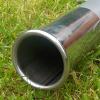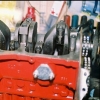Pete mentioned that with no bypass, no holes drilled in the ‘stat that the pump would be pumping a dead end. My thinking on this is that, if so, you could end up with pump cavitation at best and at worst, blowing a hose. So am I correct in that there should be some sort of ‘pressure relief’ in the water circulation circuit, whether it be via a drilled‘stat, a bypass hose or open heater valve? Or OK with no bypass but with an undrilled ‘stat with the wiggly thingy?
No.
The water Pump is a Centrifugal Pump design. The correct way to throttle or shut off flow from this type of Pump is in fact to 'valve' the Pump Outlet.
Look up 'using centrifugal pumps' and I'm sure you'll not only see the similarities between the pumps but also how they can be used.
A very long term client of mine is a Pump Designer and Manufacturer (among the world's biggest). Long time back, I had a chat and some follow up discussions with the Test Engineer (who I often worked with on special projects) about out pumps and the cooling system flow path in the A Series.
The very first item he asked about when looking at the Pump was the By-pass. He was highly critical of it as in his opinion, it would have bought the onset of cavitation on at a lower speed. He suggested if it was to be retained, to run the pump at a slower speed and increase the system pressure to around 24 PSI or higher, or do away with it. After his look at the cooling circuit flow path, the only value he could see in it was a slightly quicker warm up time, though, almost academically so, he also could see it aided with getting most of the air out on filling. The down side of running the pump slower though, was that the flow rate would be low along with low air flow (since the fan is also spinning on the same shaft). His opinion was that overall, there was next to no advantage in keeping it and that doing away with it would only be a plus in that for all practical purposes, cavitation would be a non-issue.
It's 'interesting' that Leyland it would also seem eventually cottoned on to the By-pass location an issue too, though, I don't know why but can have an educated guess.
My own findings over the last 35+ years is that I'm yet to find an issue by not running one. OK, yes, there is in fact one issue I have had without one, that is it takes a couple of 'bites' to fill the cooling system from dry, other than that, it's increased reliability and I'm sure also extended pump impeller life.























